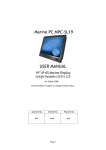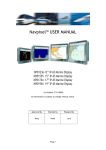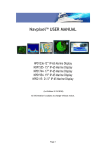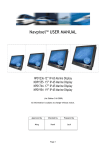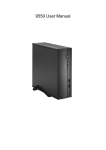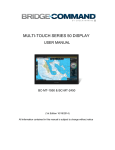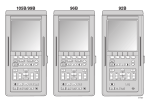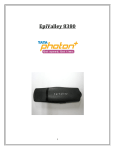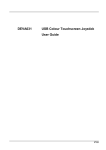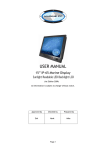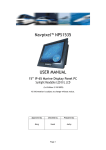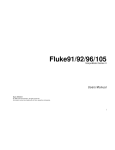Download Navpixel™ USER MANUAL
Transcript
Navpixel™ USER MANUAL NPD1236-12” IP-65 Marine Display NDP1555- 15” IP-65 Marine Display NPD1744- 17” IP-65 Marine Display NPD1954- 19” IP-65 Marine Display (1st Edition 3/31/2009) All information is subject to change without notice. Approved by Checked by Prepared by Ming Hank Jack Page 1 RECORD OF REVISION Version and Date Mar.31 2009 Page Old Description all New Description Preliminary Release Page 2 Remark TABLE OF CONTENT RECORD OF REVISION ........................................................................................................ 2 TABLE OF CONTENT....................................................................................................... 3 1.0 INTRODUCTION............................................................................................................ 7 2.0 CONTROL AND FEATURES............................................................................................. 8 3.0 INSTALLATIONS ............................................................................................................ 9 4.0 TOUCH DRIVER INSTALLATIONS.................................................................................. 15 5.0 OSD OPERATIONS....................................................................................................... 39 6.0 TECHNICAL SPECIFICATION........................................................................................ 51 7.0 MAINTENAINCE AND TROUBLESHOOTING................................................................... 59 Page 3 IMPORTANT INFORMATION EMC conformance All Navpixel equipment and accessories are designed to the best industry standards for use in the recreational marine environment. The design and manufacture of Navpixel equipment and accessories conform to the appropriate ElectroMagnetic Compatibility (EMC) standards, but correct installation is required to ensure that performance is not compromised. Waste Electrical and Electronic Equipment Directive The Waste Electrical and Electronic Equipment (WEEE) Directive requires the recycling of waste electrical and electronic equipment. Whilst the WEEE Directive does not apply to some of Navpixel’s products, we support its policy and ask you to be aware of how to dispose of this product. The crossed out wheelie bin symbol, illustrated above, and found on our products signifies that this product should not be disposed of in general waste or landfill. Please contact your local dealer, national distributor or Navpixel Technical Services for information on product disposal. Restriction of the use of certain Hazardous Substances This product uses components that comply with the requirements of the Restriction of the use of certain Hazardous Substances (RoHS) Directive 2002/95/ EC. Warranty To register your new Navpixel product, please go to: www.navpixel.com. It is important that you complete the owner information to receive full warranty benefits, including notification of software updates if they are required. Page 4 Packing List Before installation, please ensure the following items have been shipped: z 1 x Navpixel Series Marine Display z 4 x Mounting bracket lugs and 4 stainless steel threaded studs z 1 x Power Cable (5000 mm) z 1 x VGA Cable (3000 mm) z 1 x CD for User Manual and Touch Driver z 1 x Printed Flush Mount Template z 1 x Printed User Manual If any of these items should be missing or damaged, please contact your distributor or sales representative immediately. Page 5 Ordering Information Model Number Description NPD1236-EGAW-G01 12” Sunlight readable LCD, Optical bonding AR glass, 9~36V DC wide range input power NPD1236-ETAW-G01 12” Sunlight readable LCD, Optical bonding SR touch, 9~36V DC wide range input power NPD1555-EGAW-G01 15” Sunlight readable LCD, Optical bonding AR glass, 9~36V DC wide range input power NPD1555-ETAW-G01 15” Sunlight readable LCD, Optical bonding SR touch, 9~36V DC wide range input power NPD1744-EGAW-H01 17” Sunlight readable LCD, Optical bonding AR glass, 9~36V DC wide range input power NPD1744-ETAW-H01 17” Sunlight readable LCD, Optical bonding SR touch, 9~36V DC wide range input power NPD1954-EGAW-H01 19” Sunlight readable LCD, Optical bonding AR glass, 9~36V DC wide range input power NPD1954-ETAW-H01 19” Sunlight readable LCD, Optical bonding SR touch, 9~36V DC wide range input power Optional Accessories 810130001000 VGA Cable 3000mm. D-SUB15P TO D-SUB 15P 810650005110 Power Cable, DC, 5000mm, TERMINAL TO OPEN, 14AWG*2C Page 6 1.0 INTRODUCTION About Navpixel™ Marine Display Navpixel™ Series Marine Display, the high-performance, equipped with optical bonding AR glass or sunlight readable touch monitor, is specially engineered to survive the most demanding applications. You will soon become familiar with the quality difference in this bright sunlight readable (0.5 to 1,000 nits) monitor. The range of Navpixel Sunlight Viewable Marine Displays has been developed to be used as part of an integrated marine navigation system or within an entertainment system. The displays, available in several sizes, are designed to be waterproof and suitable for use above or below decks. The Navpixel™ Series Marine Display sunlight readable monitor handles a wide-range of extreme environments making it the industry choice for mobile applications. Housed in a milled billet aluminum case, the slim-profile Navpixel™ Series Marine Display is light weight and watertight. Front-mounted controls and the touch screen make the industrial rugged monitor user-friendly. We have incorporated the latest optical engineering to achieve optimal viewability in all lighting conditions, including direct sunlight. The Navpixel™ Series Marine Display’s power efficient, low heat design results in increased reliability and longevity required for mission critical deployment. This handbook contains important information on the installation, operation and maintenance of the Navpixel Sunlight Viewable Marine Display range which is intended for use in the recreational marine market and covers all models. Page 7 2.0 CONTROL AND FEATURES Your Navpixel Sunlight Viewable Marine Display has the following controls and features: Front View Remarks: The PIP function is only available for NPD1744 and NPD1954 model Back View Remarks: Only DVIx1 and VGAx1 for NPD1236 and NPD1555 model Page 8 3.0 INSTALLATIONS It is important that your new display is installed and operated in accordance with the instructions provided in this handbook. Failure to do so could result in poor product performance and may invalidate your warranty. When planning the installation the following points must be considered: • Your Navpixel display is sunlight viewable and visible in direct sunlight.. • If temperatures exceed the normal temperature operating range the display could overheat and begin to blackout due to the limitations of TFT LCD technology. • In order to minimize the chances of a malfunction, the following precautions should be taken during installation: • The display should be installed in an area where there is proper and adequate ventilation (min. 15cm clearance) . If it is possible to cool the area behind the display, it will significantly reduce the risk of a malfunction. • The display should be mounted at an angle to the sun. We do not recommend mounting the unit in a flat plane, which increases the surface area exposed to the sun and leads to increased heat absorption. IMPORTANT: Your Navpixel display is only waterproof from the front. To maintain watertight integrity the display must be flush mounted ensuring that the rear casing is enclosed in a watertight enclosure. The Navpixel™ Series Marine Display is designed to be mounted in two configurations: VESA75 / VESA100 MOUNT The Navpixel™ Series Marine Display is designed compatible with VESA75 and VESA100 mount. By installing the monitor with this kit, the user can adjust the viewing angle to improve viewability in changing environments. This mounting system has proven to be successful in supporting an extreme amount of weight in high vibration and difficult-mount applications. Page 9 The back of the monitor includes mounting points that you can use to mount the monitor as your installation requires. Mounting holes on the Navpixel™ Series Marine Display allow the monitor to be mounted by rear mounted using VESA75 or VESA100 mount PANEL (Flush) MOUNT For installation, there are four tapped mounting holes on the two sides of the unit’s panel. The mounting hardware packet is included with the product accessories in the shipping box. This packet includes four (4) stainless steel threaded studs, 3.2 cm and four (4) mounting lock nuts. Your monitor can be installed using the mounting lock nuts (supplied) in the vertical keyways. Make sure that both brackets are in the same orientation. Preparing the installation site 1. Select an installation site that has sufficient space behind for cable connections and ventilation. 2. Tape the supplied flush mount template in the required position. 3. Using a jigsaw, carefully remove the shaded portion of the template. 4. Using a suitable file, smooth the edges of the aperture. Page 10 Installing the display 1. Carefully insert the monitor into the aperture, ensuring that the gasket on the rear of the fascia lays flat against the aperture edge. IMPORTANT: The gasket must lay flat against the aperture edge to ensure watertight integrity. 2. Place the mounting bracket lugs into the keyways and move them to the rear, securing the bracket to the monitor. Note: The mounting brackets can be used in either the horizontal or vertical keyways as required. 3. Using a suitable screwdriver, tighten the mounting bracket screws to secure the monitor in position. Page 11 4. Connect all cables as required - see “Rear connections” below. Rear connections Remarks: The photo above will differ for different model The rear connectors are: 1. FUSE 2. Power Input 3. DVI-1 Input 4. DVI-2 Input (N/A for NPD1236 & NPD1555) 5. VGA-1 Input 6. VGA-2 Input (N/A for NPD1236 & NPD1555) 7. CVBS-1 Input (Composite Video) for AV input 8. CVBS-2 Input (Composite Video) for AV input 9. CVBS-3 Input (Composite Video) for AV input 10. RS232 Input 11. USB for Touch control (option) Planning the installation Before you install your display, the following points should be considered: • Power requirements. • Display location and mounting options. • Additional accessories, e.g. keyboard or speakers. Power requirements Your Sunlight Viewable display is designed to run on boat’s DC power systems rated at 12 V or 24 V. Navpixel Series Marine Display is equipped with 9~36V DC wide range power input and is capable for such kind of application. The DC power system should be either: • Negative grounded, with the negative battery terminal connected to the boat’s ground, • Floating, with neither battery terminal connected to the boat’s ground. Grounding the display It is important that an effective radio frequency (RF) ground is connected to the display. You must ground the display by connecting the drain wire (shield) of the power input cable to the nearest ground point of the boat’s RF ground system. Page 12 Display location and mounting options Your display can be mounted using the flush mounting kit supplied. Navpixel recommends that you power the unit and select a suitable mounting location prior to installing the display. When planning the display location, the following points should be considered to ensure safe, comfortable and reliable operation: • Convenience- the mounting location should be easily accessible to allow operation of the controls and should enable easy viewing of the display. Power connections The power connection to the display should be made at either the output of the battery isolator switch, or at a DC power distribution panel. Navpixel recommends that power is fed directly to the display via its own dedicated cable system and MUST be protected by a thermal circuit breaker or fuse, fitted close to the power connection. If you do not have a thermal circuit breaker or fuse in your power circuit, you MUST fit an in-line breaker or fuse to the positive (red) lead of the power cable. • Installation angle- the display should be mounted at an angle. Mounting it in a flat plane is not recommended due to increased heat absorption. • Viewing angle - this LCD has been chosen to give the very best performance, including viewing angle. However, the contrast and colors seen on all LCD displays vary slightly with viewing angle. • Environment - to prevent overheating, do not restrict airflow at the rear of the display unit; If the space behind the display is air conditioned or cooled by a fan, it will help in keeping the unit’s temperature down when mounted in direct sunlight. FAILURE TO ADEQUATELY VENTILATE THE UNIT COULD INVALIDATE YOUR WARRANTY. The display should be protected from physical damage and excessive vibration. Although the display unit is waterproof from the front when installed correctly, it is good practice to mount it in a protected area away from prolonged and direct exposure to rain and salt spray. DO NOT place the display near to a heat source. Page 13 Typical Installation Diagram Remarks: The real installation diagram above is only for reference and will differ for different kind of customer’s applications Page 14 4.0 TOUCH DRIVER INSTALLATIONS Both AR glass and Resistive touch screen solutions are used for our products. If you have a customized or tailored product, please check the specifications in this manual or provide us your third-party specifications. Resistive Touch Screen It generally uses a display overlay composed of layers, each with a conductive coating on the interior surface. Special separator “dots” are distributed evenly across the active area and separate the conductive interior layers. The pressure from using either a mechanical stylus or finger produces an internal electrical contact at the “action point” which supplies the controller with vertical and horizontal analog voltages for data input. The resistive touch screens are anti-glare to reduce reflective shine intensity, which will slightly diffuse the light output throughout the screen. Resistive technology activation can be initiated by; a gloved hand, fingernail, mechanical stylus or an ungloved finger. Resistive Touch - Brief Specifications Subject Input Method Touch Activation Force Insulation Resistance Light Transmission Operating Temperature Storage Temperature Humidity (Operating) Surface Hardness Expected Life Details Finger & Stylus Finger & Stylus Touch Stylus Touch Stylus Gloved Hand 0.10 - 0.80N (10 - 80g) 10M ohm @ 25V DC > 80% -10℃ to +60℃ -40℃ to +80℃ less than 80% RH 3H or higher 10 million single point activation Before installing the Windows 2000、XP32/64bit、2003、Vista32/64bit driver software, you must have the Windows 2000、XP32/64bit、2003、Vista32/64bit system installed and running on your computer. You must also have one of the following PenMount 5000/6000/9000 series controller or control boards installed: PM5184 , PM5126 , PM51A5, PM6500 , PM6300, PM6200C, PM9084 , PM9026 , PM9036 , PM90A4. Installing Software If you have an older version of the PenMount Windows 2000、XP32/64bit、2003、 Vista32/64bit driver installed in your system, please remove it first. Follow the steps below to install the PenMount Windows Universal driver. 1. Please make sure your PenMount device had plugged in advance. If your device uses RS-232 interface, please plugged in before the machine is turned on. When the system first detects the controller board, a screen appears that shows "Unknown Device". Do not use this hardware wizard. Press Cancel. 2. Insert the PenMount Driver CD-ROM. Go to the Windows Universal Driver folder. Page 15 Click “setup.exe.” 3. A License Agreement appears. Click “I Agree” and “Next” Page 16 4. Ready to Install the Program. Click “Install” 5. Installing may be will spend sometime. Page 17 6. When the warning message screen appears, please click “Install this driver software anyway” to continue. For RS232 interface, it will appear one time. For USB interface, it will appear twice. 7. The “InstallShield Wizard Completed” appears. Click “Finish”. If you are installing the driver with Microsoft WHQL, you will see the screen in step 7 directly instead of step 6. Please restart your Windows system after installation finishes. Page 18 8. If you installed PenMount driver package 2.1.0.187 and after, you can use the “Refresh” function in PenMount Control Panel to detect and install newly attached PenMount devices. Software Functions Upon rebooting, the computer automatically finds the new PenMount controller board. The touch screen is connected but not calibrated. Follow the procedures below to carry out calibration. 1. After installation, click the PenMount Monitor icon “PM” in the menu bar. 2. When the PenMount Control Panel appears, select a device to “Calibrate.” PenMount Control Panel The functions of the PenMount Control Panel are Device, Calibrate, Setting, Multiple Monitors ,Tools and About, which are explained in the following sections. Page 19 Device In this window, you can find out that how many devices be detected on your system. Page 20 Calibrate This function offers two ways to calibrate your touch screen. ‘Standard Calibration’ adjusts most touch screens. ‘Advanced Calibration’ adjusts aging touch screens. Page 21 1. Please select a device then click “Configure”. You can also double click the device too. 2. Click “Standard Calibration” to start calibration procedure Page 22 NOTE: The older the touch screen, the more Advanced Mode calibration points you need for an accurate calibration. Use a stylus during Advanced Calibration for greater accuracy. Please follow the step as below: 3. Come back to “PenMount Control Panel” and select “Tools” then Click “Advanced Calibration”. Page 23 Select “Device” to calibrate, then you can start to do “Advanced Calibration”. NOTE: Recommend to use a stylus during Advanced Calibration for greater accuracy. Page 24 Setting Page 25 Edge Compensation This page is the edge compensation settings for the advanced calibration. You can adjust the settings from 0 to 30 for accommodating the difference of each touch panel. Page 26 About This panel displays information about the PenMount controller and driver version Multiple Monitors Multiple Monitors supports from two to six touch screen displays for one system. The PenMount drivers for Windows 2000、XP32/64bit、2003、Vista32/64bit support Multiple Monitors. This function supports from two to six touch screen displays for one system. Each monitor requires its own PenMount touch screen control board, either installed inside the display or in a central unit. The PenMount control boards must be connected to the computer COM ports via the RS-232 interface. Driver installation procedures are the same as for a single monitor. Multiple Monitors supports the following modes: Windows Extend Monitor Function Matrox DualHead Multi-Screen Function nVidia nView Function NOTE: The Multiple Monitors function is for use with multiple displays only. Do not use this function if you have only one touch screen display. Please note once you turn on this function the Rotating function is disabled. Enable the multiple display function as follows: Page 27 1. Check the “Multiple Monitor Support” box; then click “Map Touch Screens” to assign touch controllers to displays. 2. When the mapping screen message appears, click “OK” Page 28 3. Touch each screen as it displays “Please touch this monitor. Press ‘S’ to skip” Following this sequence and touching each screen is called mapping the touch screens. 4. After the setting procedure is finished, maybe you need to calibrate for each panel and controller NOTES: 1. If you used a single VGA output for multiple monitors, please do not use the Multiple Monitors function. Just follow the regular procedure for calibration on each of your desktop monitors. 2. The Rotating function is disabled if you use the Multiple Monitors function. 3. If you change the resolution of display or screen address, you have to redo Map Touch Screens so the system understands where the displays are. 4. If you more monitor mapping one touch screen, Please press ‘S’ to skip mapping step. Page 29 An example for 2 units of touch monitor a. Please make sure the touch monitor had plugged in and detected. Page 30 b. click “Map Touch Screens” then click “OK" c. Please follow the message show the display to match the controller and touch screen c-1. Please click “S” to skip if the monitor without use touch screen. Page 31 c-2. When screen jump to Screen 2, please touch it. If screen 2 has no touch function, press “S” to skip it. d. Before doing the calibration, you have to finish the procedure of “Map touch screens” d-1. Please do the calibration for each device in sequence. Page 32 d-2. Press each device & start to do standard Calibration, for instance, device 0. d-3. After press device 0, one of screens will show calibration map. Please follow points to calibrate it. When you completed one device, do please do others as the same way. Page 33 Tools Page 34 About You can see how many devices of PenMount controller that are plugged to your system PenMount Monitor Menu Icon The PenMount monitor icon (PM) appears in the menu bar of Windows 2000/XP/2003/Vista system when you turn on PenMount Monitor in PenMount Utilities. Page 35 PenMount Monitor has the following function PenMount Rotating Functions The PenMount driver for Windows 2000/XP 32 bit/Vista 32/64bit supports several display rotating software packages. Auto detect rotate function (0°, 90°, 180°, 270°). Windows 2000/XP 32 bit/Vista 32/64bit support display rotating software packages such as: • Portrait’s Pivot Screen Rotation Software • ATI Display Driver Rotate Function • nVidia Display Driver Rotate Function • SMI Display Driver Rotate Function • Intel Display Driver Rotate Function Page 36 Configuring the Rotate Function on Windows XP 64 bit 1. There is a “screen rotation monitor” function only appears in the PenMount driver utilities for Windows XP 64 bit Edition. 2. On enabling the ”Screen Rotation Monitor”, you can see a screen like below : 3. Choose the rotate function (0°, 90°, 180°, 270°) in the 3rd party software. The calibration screen appears automatically. Touch this point and rotation is mapped. NOTE: The Rotate function is disabled if you use Monitor Mapping Page 37 Uninstall Software 1. Exit the PenMount monitor (PM) in the menu bar in advance. 2. Go to Settings, then Control Panel, and then click “Add/Remove program” 3. Select ”PenMount Universal Driver 1.0”. Click the “Chang/Remove” button. 4. Select ‘Yes’ to remove the PenMount driver. 5. Select ‘Yes’ to reboot your system or ‘No’ to reboot your system later. Page 38 5.0 OSD OPERATIONS (Remarks: PIP function is only available for NPD1744 and NPD1954 model) Introduction Your Navpixel Sunlight Viewable display can be controlled using the On Screen Display (OSD) menu and/or the 8 buttons on the front bezel of the unit. The OSD menu enables you to change the way in which your display is set up and is accessed using the Menu button. Using the buttons Each of the 8 buttons on the front bezel of your display has an input and a control function. Input functions enable you to select the type of signal input to the display. Control functions enable you to change the appearance of the display. Power Power ON Key To power your monitor ON, just need to press this button and it will delay the power on sequence around 3 seconds. This is Navpixel’s brand new design to well protect your Navpixel Sunlight Viewable display damaged in the surge voltage from the engine. Power OFF Key To power your monitor OFF, just need to press this button and it will also delay the power off sequence around 3 seconds. Pressing the power button will display a list of what input for the main screen is associated with each button. This is just a reminder and is not part of the input selection process. Page 39 BRIGHTNESS Key When you press the BRIGHTNESS Key, the screen will show the following image You can press the UP /DOWN Key to do the screen brightness adjustment. When the brightness achieve 50 and keeping pressing “UP” Key, the dimming will keep the brightness at 50. When you dimming down to brightness 1 and keeping pressing the “DOWN” Key, the dimming will keep the brightness at 1. If you keep pressing “BRIGHTNESS” Key and hold it, the brightness will appear as following status: . . . .2 Æ 1 → 2→ 3 → . . . Æ 48 Æ 49 Æ 50 Æ 49 Æ 48 Æ . . . . And if you release the “BRIGHTNESS” Key around 5 seconds with any action, the brightness bar will disappear. When you press “BRIGHTNESS” Key and other Key (not including Up/Down Key), the BRIGHTNESS status bar image will disappear. When you press NIGHT MODE KEY or choose VR adjustment, the BRIGHTNESS KEY will be no function if you press it. VR BRIGHTNESS Key If you want to enable the VR Brightness function, you need to press “MENU” KEY and then choose VR function. When you rotate the VR knob, the VR BRIGHTNESS status bar will appear as below image (dimming range from 1~50): When you enter the VR BRIGHTNESS mode, it will be no function if you press the BRIGHTNESS KEY. And if you release the VR knob without any action around 5 seconds, the VR BRIGHTNESS Status bar image will be closed. When you enter the “NIGHT MODE” or choose “BRIGHTNESS” Key for brightness adjustment, it will be no function if you control the VR knob. When you press “MENU”, “DISP”, “PIP” Key, you will enter the menu item selection. And the VR BRIGHTNESS status bar image will be closed. Any modified or changed parameter setting will be automatically saved if you power off or Exit the BRIGHTNESS status bar. Page 40 NIGHT MODE KEY When you press the “NIGHT MODE” KEY, the dimming will be down to under 0.5 nit directly. And if you press “BRIGHTNESS” KEY or “VR” knob at this moment, it will be no function until you press the “NIGHT MODE” KEY again to release this restriction. When you press “MENU”, “DISP”, “PIP” Key, you will enter the menu item selection. Any modified or changed parameter setting will be automatically saved if you power off or Exit the NIGHT MODE. UP / DOWN KEY It works as menu item selection use, the “UP”KEY can be used as “RIGHT” KEY and the “DOWN” KEY can be used as “LEFT”KEY. INPUT KEY When you press “INPUT” KEY, the screen will pop up the following image: You can press the “UP”/ ”DOWN” KEY for the menu item selection above. It will remain at “VIDEO 3” position if you keep pressing “DOWN” KEY to the end. And it will also remain at “RGB1” position if you keep pressing “UP” KEY to the end. When you press and hold the “INPUT” KEY, the menu screen will show as RGB1→RGB2→..→VIDEO3→VIDEO2→.. If you release the “INPUT” KEY for 5 seconds without any action, the menu selection screen will be closed. And it will remain at the item which you’d selected. When you press “MENU”, “BRIGHTNESS”, “PIP” Key, you will enter the menu item selection. Any modified or changed parameter setting will be automatically saved if you power off or Exit the menu setting screen. Page 41 PIP KEY 1. 2. 3. 4. 5. Default Default Default Default Default (Remarks: PIP KEY is no available for NPD1236 and NPD1555 model) main main main main main screen screen screen screen screen shows at RGB1 & RGB2Æ Press “PIP” KEYÆ Figure 1 stays at DVI1 & DVI2Æ Press “PIP” KEYÆ Figure 2 stays at VIDEO 1Æ Press “PIP” KEYÆ Figure 3_1 stays at VIDEO 2Æ Press “PIP” KEYÆ Figure 3_2 stays at VIDEO 3Æ Press “PIP” KEYÆ Figure 3_3 PIP Function Supporting Table Sub RGB 1 Main RGB 1 RGB 2 DVI 1 OK DVI 2 OK VIDEO 1 OK VIDEO 2 OK VIDEO 3 RGB 2 DVI 1 DVI 2 VIDEO 1 VIDEO 2 VIDEO 3 OK OK OK OK OK OK OK OK OK OK OK OK OK OK OK OK OK OK OK OK OK OK OK OK OK OK OK OK OK OK OK OK OK Figure 1 OK Figure 1 Figure 1 Figure 2 Figure 2 Figure 3_1 Figure 3_2 Figure 3_3 Figure 2 Figure 3_1 Figure 3_2 Page 42 Figure 3_3 When you enter the “PIP Port Change” screen, the status bar will remain at “OFF” position if you keep pressing the “DOWN” KEY to the end. At the other hand, the status bar will remain at top item of each menu if you keep pressing the “UP” KEY to the end. When you press and hold the “PIP” KEY, the menu screen will show as: DVI→VIDEO1→VIDEO2→VIDEO3→OFF→VIDEO3→VIDEO2→VIDEO1→DVIÆVIDEO1Æ… If you release the “INPUT” KEY for 5 seconds without any action, the menu selection screen will be closed. And it will remain at the item which you’d selected. When you press “MENU”, “BRIGHTNESS”, “PIP” Key, you will enter the menu item selection. Any modified or changed parameter setting will be automatically saved if you power off or Exit the menu setting screen. MENU KEY When you press “MENU” KEY, the Navpixel OSD main menu screen will appear as below: If you release the “MENU” KEY for 30 seconds without any action, the menu OSD screen will disappear automatically. You can also choose “QUIT” and then press “MENU” KEY to exit this OSD menu screen. Page 43 RGB1 & 2’s setting screen: (Remarks: Only RGBx1 for NPD1236 and NPD1555 model) RGB Setting Item Description: ・ PHASE――― Horizontal Sampling Phase Adjustment。 ・ CONTRAST――― Contrast Adjustment。 ・ H_POSITION―― Horizontal Screen Adjustment。 ・ V_POSITION―― Vertical Screen Adjustment。 ・ R_LEVEL――― Red Color level Adjustment。 ・ G_LEVEL――― Green Color level Adjustment。 ・ B_LEVEL――― Blue Color level Adjustment。 ・ TEMPERATURE――― Color Temperature Adjustment。 ・ DISP MODE――― FULL――― Full Screen。 EVEN――― Half Screen。 NORMAL―― Keep normal aspect ratio。 ・ AUTO ADJUST――― Auto adjustment。 ・ EXIT――― Quit from current setting。 ・ (Remarks: DISP MODE is not available for NPD1236 and NPD1555 model) Page 44 DVI 1 & 2’s setting screen: (Remarks: Only DVIx1 for NPD1236 and NPD1555 model) DVI Setting Item Description: ・ CONTRAST―――Contrast Adjustment。 ・ R_LEVEL――― Red Color level Adjustment。 ・ G_LEVEL――― Green Color level Adjustment。 ・ B_LEVEL――― Blue Color level Adjustment。 ・ TEMPERATURE――― Color Temperature Adjustment。 ・ DISP MODE――― FULL――― Full Screen。 EVEN――― Half Screen。 NORMAL―― Keep normal aspect ratio。 ・ EXIT――― Quit from current setting。 (Remarks: DISP MODE is not available for NPD1236 and NPD1555 model) Page 45 VIDEO 1 & 2 & 3’ setting screen: VIDEO Setting Item Description: ・ CONTRAST――― Contrast Adjustment。 ・ SHARPNESS――― Horizontal edge sharpness ・ HUE――― Color Adjustment ・ R_LEVEL――― Red Color level Adjustment。 ・ G_LEVEL――― Green Color level Adjustment。 ・ B_LEVEL――― Blue Color level Adjustment。 ・ TEMPERATURE――― Color Temperature Adjustment。 ・ EXIT――― Quit from current setting。 (Remarks: HUE function is not available for NPD1236 and NPD1555 model) Page 46 PIP Sub-menu setting screen: (Remarks: PIP function is not available for NPD1236 and NPD1555 model) PIP Setting Item Description: ・ PIP_SIZE――― Picture in Picture Screen Size Adjustment。 ・ CONTRAST――― Contrast Adjustment。 ・ R_LEVEL――― Red Color level Adjustment。 ・ G_LEVEL――― Green Color level Adjustment。 ・ B_LEVEL――― Blue Color level Adjustment。 ・ EXIT――― Quit from current setting。 Page 47 OSD setting screen: OSD Setting Item Description: ・ H_POSITION―― Horizontal Screen Adjustment。 ・ V_POSITION―― Vertical Screen Adjustment。 ・ TRANSLUCENT――― Screen background color can be adjusted as transparent as you want (total 10 scales)。 ・ BRIGHTNESS――― Selection between “BRIGHTNESS” key or “VR” Button for brightness adjustment。 ・ SYSTEM RETURN――― Restore all parameter setting to factory default value。 ・ EXIT――― Quit from current setting。 (Remarks: TRANSLUCENT function is not available for NPD1236 and NPD1555 model ) SYSTEM RETURN setting screen: Page 48 You may choose “SYSTEM RETURN” selection item on the OSD Screen to restore all of the parameter setting to factory default value. When you press “UP” or “RIGHT” KEY, the parameter will show “YES” and confirm it. Page 49 “KEY LOCK” Mode Function setting screen: When you press “MENU” and “BRIGHTNESS” KEY simultaneously for 3 seconds, you will enter the “KEY LOCK” mode. At the same time, the screen will show “KEY LOCK” image as below for 5 seconds and then disappear. In the “KEY LOCK” mode, it will be no function to press any key. When you press the key in the “KEY LOCK” mode, the screen will show “KEY LOCK” image as below for 5 seconds and then disappear. To Release/Unlock “KEY LOCK” Mode Function setting screen: In the “KEY LOCK” mode, when you press “MENU” and “BRIGHTNESS” KEY simultaneously for 3 seconds, you will release/unlock the “KEY LOCK” mode. At the same time, your screen will show “KEY UNLOCK” image as below. Page 50 6.0 TECHNICAL SPECIFICATION 6.1 Specification- NPD1236 LCD Display Backlight 12" LED Backlight Active Display Area Brightness 245.76x184.32 mm 1000 cd/m2 * Resolution 1024x768 (XGA) Contrast Ratio Pixel Pitch (mm) 800:1 0.24(H)x0.24(V) Viewing Angle 140 (H), 140(V) Display Color 262,144 Response Time Tr: 6ms, Tf: 17ms Inputs VGAx1, DVIx1, Composite x3, RS232x1 Mechanical IP Rating Facial waterproof to IP65 standards when console mounted. Construction Rugged Aluminum Alloy Chassis Mounting Panel (Flush) mount, VESA mount Dimension 297.2(w)x256(H)x56(D) Power Voltage Operates on 12V and 24V systems Power Consumption 38W Environmental Operating Temperature -10°C~50°C Non-Operating Temperature -20°C~70°C Certification Designed to meet FCC Class A, Marine standard EN60945 * The brightness is measured under the 25°C ambient temperature before touch attached. Due to Panel material's deviation, different panel supplier will set different specific variance range to optical characteristics. The factors of time used, Lamp current, ambient temperature will influence the optical measurements. Page 51 6.2 Specification- NPD1555 LCD Display Backlight 15" LED Backlight Active Display Area Brightness 304.128 x 228.096 mm Resolution 1024x768 (XGA) Contrast Ratio Pixel Pitch (mm) 700:1 0.297(H) x 0.297 (V) Viewing Angle 160 (H), 160(V) Display Color 16.2M Response Time Tr:8ms, Tf:17ms Inputs VGAx1, DVIx1, Composite x3, RS232x1 1000 cd/m2 * Mechanical IP Rating Facial waterproof to IP65 standards when console mounted. Construction Rugged Aluminum Alloy Chassis Mounting Panel (Flush) mount, VESA mount Dimension 352.8(W)x303.3(H)x56(D) Power Voltage Operates on 12V and 24V systems Power Consumption 63W Environmental Operating Temperature -10°C~50°C Non-Operating Temperature -20°C~70°C Certification Designed to meet FCC Class A, Marine standard EN60945 * The brightness is measured under the 25°C ambient temperature before touch attached. Due to Panel material's deviation, different panel supplier will set different specific variance range to optical characteristics. The factors of time used, Lamp current, ambient temperature will influence the optical measurements. Page 52 6.3 Specification- NPD1744 LCD Display Backlight 17" LED Backlight Active Display Area Brightness 337.92 x 270.336mm Resolution 1280x1024 (SXGA) Contrast Ratio Pixel Pitch (mm) 1000:1 Viewing Angle 160 (H), 160(V) Display Color 16.2M Response Time 5ms Inputs VGAx2, DVIx2, Composite x3, RS232x1 Picture in Picture 3 stages 1000 cd/m2 * 0.264 (H) x 0.264(V) Mechanical IP Rating Facial waterproof to IP65 standards when console mounted. Construction Rugged Aluminum Alloy Chassis Mounting Panel (Flush) mount, VESA mount Dimension 384(w)x348.1(H)x57.8(D) Power Voltage Operates on 12V and 24V systems Power Consumption 71W Environmental Operating Temperature -10°C~50°C Non-Operating Temperature -20°C~70°C Certification Designed to meet FCC Class A, Marine standard EN60945 * The brightness is measured under the 25°C ambient temperature before touch attached. Due to Panel material's deviation, different panel supplier will set different specific variance range to optical characteristics. The factors of time used, Lamp current, ambient temperature will influence the optical measurements. Page 53 6.4 Specification- NPD1954 LCD Display Backlight 19" LED Backlight Active Display Area Brightness 376.32 x 301.06mm Resolution 1280x1024 (SXGA) Contrast Ratio Pixel Pitch (mm) 900:1 0.294(H) x 0.294 (V) Viewing Angle 160 (H), 160(V) Display Color 16.2M Response Time 5ms Inputs VGAx2, DVIx2, Composite x3, RS232x1 Picture in Picture 3 stages 1000 cd/m2 * Mechanical IP Rating Facial waterproof to IP65 standards when console mounted. Construction Rugged Aluminum Alloy Chassis Mounting Panel (Flush) mount, VESA mount Dimension 421.9(w)x304.1(H)x56(D) Power Voltage Operates on 12V and 24V systems Power Consumption 48W Environmental Operating Temperature -10°C~50°C Non-Operating Temperature -20°C~70°C Certification Designed to meet FCC Class A, Marine standard EN60945 * The brightness is measured under the 25°C ambient temperature before touch attached. Due to Panel material's deviation, different panel supplier will set different specific variance range to optical characteristics. The factors of time used, Lamp current, ambient temperature will influence the optical measurements. Page 54 6.5 ME Drawing- NPD1236 Page 55 6.6 ME Drawing- NPD1555 Page 56 6.7 ME Drawing- NPD1744 Page 57 6.8 ME Drawing- NPD1954 Page 58 7.0 MAINTENAINCE AND TROUBLESHOOTING Precautions To maximize the life and safe use of your unit, always be sure to follow the warnings, precautions and maintenance recommendations in this user’s guide. In a Watercraft or Vehicle: z The monitor should be visible to the driver only if it is used for navigation, or system control. Care should be taken to ensure distraction does not occur. z Review all applicable federal, state and local laws and regulations to make sure the monitor is used properly and safely. z Avoid using the monitor for extended times while the charging system is not running, or the monitor could drain the watercraft’s battery. Maintenance High Voltage W A R N IN G ! The display unit contains high voltages. 01. To reduce the risk of electric shock, do not remove the cover or back. There are no user-serviceable parts inside. 02. Make sure you turn off and unplug the display before installing devices. Cleaning the display Cleaning DO NOT use acid, ammonia based or abrasive products. CAUTION! 1. Use a soft cloth moistened with mild detergent, isopropyl alcohol, or window cleaners to clean the display housing. 2. Ensure the display is disconnected from the power supply. Wipe the display with a clean, damp cloth. 3. If necessary use iso-propyl alcohol (IPA) or a mild detergent to remove grease marks. 4. Never use abrasive cleaners, waxes or solvents to clean the unit. Disconnecting the power supply To disconnect the display from the boat’s power supply either; • Isolate the power cable from the main supply, or, • Remove the power connector from the rear of the monitor. The power button on the front of the monitor changes the operating mode; it does not provide complete protection in an emergency Page 59 Troubleshooting All Navpixel products are, prior to packing and shipping, subjected to comprehensive test and quality assurance programs. However, if this unit should develop a fault, please refer to the following table to identify the most likely cause and the corrective action required to restore normal operation. If you still have a problem after referring to the table below, contact your local dealer, national distributor or Navpixel Technical Services Department for further advice. Common problems and their solutions Problem Solution The display is very dim or dark Adjust the display as described in “Image adjustment on ” Section 5 OSD Menu. The display shows the message ‘No Input’ Check that the video source i.e. display, camera, DVD etc. is powered and that the cables are correctly connected. You have pressed the power button, but the display does not function. 1. Make sure that the power cable is well connected and that all connections are tight and free from corrosion. 2. Check the system fuse. Page 60






























































